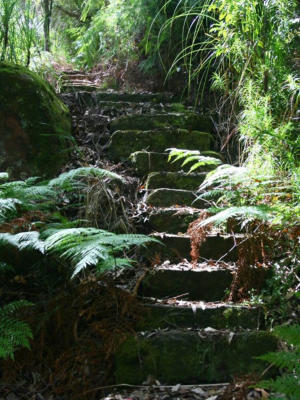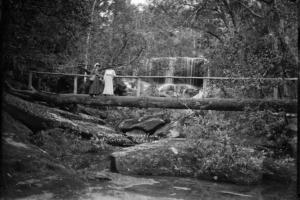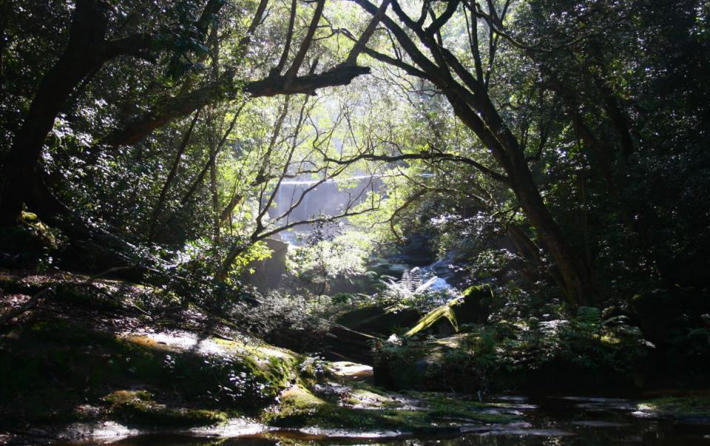




Somersby Falls – A Hidden Gem That Never Grew Up To Be Famous
Near Mangrove Mountain on the Central Coast, only 25 minutes
drive from central Gosford, lies one of NSW’s prettiest and least
known waterfall systems – Somersby Falls. If it was located in the
Blue Mountains it would be one of the highlights of the region, but
instead it is found in the middle of a quiet and isolated farming
area which is better known for its orchards of oranges and stone
fruits.
In 1886 Henry Pile and his wife were the first Europeans to settle
into Somersby, still wilderness dotted with huge masses of
wildflowers. He was told of Somersby Falls by either local
Aboriginals or by whites living closer to town. Sometime in the
1880’s/1890’s he started to take an active interest in Somersby
Falls and together with a few other locals, they gave their time
voluntarily and built paths, handpicked sandstone stones for steps
and opened up the little rainforest valley so others could enjoy it.
Even by 1901 word had spread and people were already picnicking
and exploring the Falls, using Pile’s ‘circuit of steps’ to walk around
the area. Around this time it was also designated as a reserve
under NSW Department of Lands, and Pile along with others
became volunteer trustees.
Initially it had been expected that the main Eastern NSW train line
would pass through this immediate region, not far from the Falls.
But the completed railway in 1889 went a different route, on the
foreshores and nearer to the water as seen today. If it had followed
the original route, there is every possibility that Somersby Falls
could have ended up with its own train station and likely it would
have become as accessible and popular as The Three Sisters, or
similar.
Near the bottom of the walking circuit at the Falls lay a very large
tree across Floods Creek, and it became a ‘bridge’ for people to
cross the rushing waters. It is unknown if this was a natural
coincidence or if talented tree-fellers carefully fell one of the giants
in this direction, either way they added a handrail and for many
decades it served its purpose. Locals growing up in Somersby in
the 1960’s remember that old tree lying across the creek although
by then it was rotted and slippery and only for risk-takers.
The series of stone steps were built on the west side to lead down
to the bridge, and then on the east side, returning to the top,
another series of steps was completed. Sometime around WW II
the Falls and the bridge fell into general disuse, and over time the
steps were forgotten.
However the stone steps are still in place today, overgrown but
there for all to see. But only if you are fit and agile and with sturdy
walking shoes, as the very thick, slope-sided terrain up in there is
both dangerous and slippery. Indeed it is a discovery waiting for
the experienced bushwalkers.
In the early 1980’s the area was taken over by NPWS and now
Somersby Falls just sits within the Brisbane Water National Park
boundaries. The old wooden steps near the top were immediately
replaced and made safer and toilets, a BBQ, picnic tables and
parking were added.
Prior to that it had been a somewhat primitive reserve under
Council supervision and the very last local volunteer to help
maintain the site was Ian Moss-Robinson who lived right next door
to the front gates. Unfortunately he died of a heart attack in late
1971 after either walking the Falls circuit or working on some
repairs of the wooden steps. Ian was the son of one of Australia’s
first well-known naturalists, Leslie Mosse-Robinson, who lived at
Narara and was quite famous in worldwide scientific circles for his
expert knowledge, collection and study of native animals, mainly
native butterflies and moths.



Somersby Falls, NSW
Written and photographed by Peter Fisher
Disability access
"with a helper or two you could get a wheelchair in to see
the first turn-off on the trail/steps, where you can see the top
little falls. Unless they were really keen, I doubt many would
try getting a wheelchair down to the bigger falls. But young
folk with commitment could do it, yes. Steps and pathway
all the way"





























